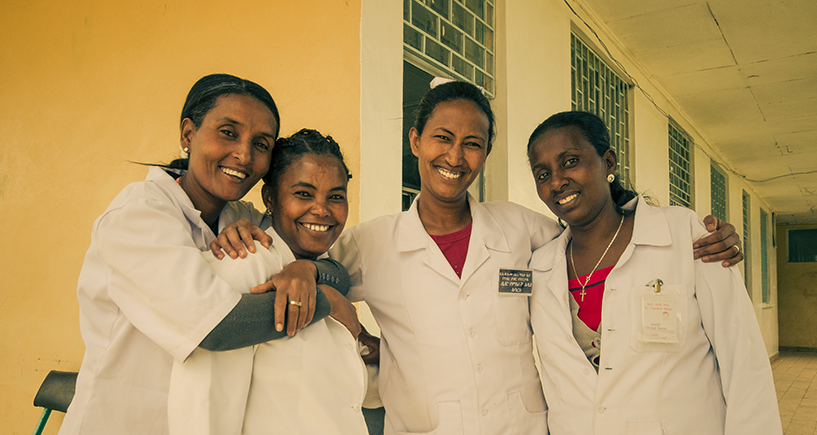Inspiring Leadership: Cultivating a Culture of Quality for the Health of Women, Children and Adolescents
Inspiring Leadership: Cultivating a Culture of Quality for the Health of Women, Children and Adolescents
By: Seneca Moore
This story was originally published by Women Deliver

In recent decades, a great deal of resources have been invested in the delivery of essential health services, especially through support to the six building blocks of strong health systems – health financing, health workforce, health information, health governance, medical products, and service delivery. These investments have been hugely important and effective in forming a foundation, supporting frontline health workers to save lives, and in securing unprecedented commitment to the common goal of achieving universal health coverage (UHC).
But the fact remains that over half the world’s population – women, children, and adolescents in particular – is still unable to access the high quality health services they need.
Women, children and adolescents remain underserved by health systems and suffer a disproportionate burden of morbidity and mortality, which endangers the broader well-being of the whole of society.
At Management Sciences for Health (MSH), we are innovating and building on these foundations by strengthening leadership and governance as the backbone of health systems that can make UHC a reality for women and children. While health systems are made up of organizations, structures, and processes, it is human relationships that make them work. Our experience has shown that constructing a modern health center and providing it with a budget, medicines, supplies, and qualified health workers – while complex, difficult, and absolutely necessary – is only the beginning.
Time and again, we have seen that consistent, transparent institutional governance and inspiring leadership is the key to achieving quality of care and better performing health systems and services.
In Western Uganda, we’ve seen leaders transform the way prenatal and obstetric services are delivered in their hospitals by motivating teams and empowering them to address obstacles in community outreach, health education, and supply stock-outs. Just one year after engaging in our leadership development programs, Kagando Hospital recorded 11% more women delivering at the hospital, 27% more women going to antenatal care, and a doubling of contraceptive use among women and young adolescents. For young women like Rachel Kabugho, the hospital’s focus on leadership and quality care meant that staff were given the skills, resources, and confidence needed to quickly determine that her baby was malpositioned during labor, making a vaginal delivery both difficult and dangerous, and take the decisive action that led to the safe birth of her new daughter, Bira.
For a health center to achieve real and sustainable impact on the health of women, children, and adolescents in its community, we must think of leadership and governance as more than just about the people in charge and the institutions that govern.
The manager of a health facility must cultivate a culture of quality by providing strong, sensitive, inspiring supervision to her staff while maintaining effective working relationships with health providers working across the communities the facility serves. They, in turn, must listen and offer guidance, enable her to solve problems and connect her to the resources and technical expertise she needs to provide quality care to patients. To provide high-quality services, health workers must also actively engage with the concerns of the community. And those working at the community level must be motivated and equipped to link families and vulnerable individuals to the respectful, people-centered care they need.
At its core, effective health facility governance is all about building strong human relationships around common goals – connecting community, facility, and the broader health systems. This must be true at every level and for every person in the health system, as everybody’s efforts are essential for the consistent effectiveness we need to reach all women, children, and adolescents, and to achieve UHC.
Looking at this from another angle, for these systems to be responsive to the needs of the community, women, children, and adolescents must be actively and meaningfully engaged in designing, implementing, and evaluating health interventions. In Malawi, USAID’s flagship health program, the MSH-led Organized Network of Services for Everyone’s (ONSE) Health Activity is demonstrating this. The program is using mobile clinics to reach adolescents, to build positive relationships, and to offer individualized, stigma-free comprehensive family planning counseling and HIV testing. The program also helps communities hold health systems accountable and rate the quality of care they receive in health facilities using scorecards, and they collaborate with healthcare providers and local government to find solutions to problems.
Similarly, in the Lea Mimba project in Kenya, women, midwives, and other stakeholders have participated in co-designing a group antenatal care service model that responds to women’s needs for evidence-based antenatal care that is delivered with care, respect, and connection.
Strengthening leadership and governance is only one part of what must be a larger, more comprehensive effort to achieve UHC – but it is a fundamental one leading to healthier and more prosperous societies.
Healthy women are more productive contributors to their families, communities, and society at large, and they have less financial risk, so their families can keep more disposable income rather than saving funds to cover health costs. This, in turn, boosts cash flow and spurs economic growth. When children and adolescents are healthy enough to go to school, they too have a better chance of becoming active contributors in the future. It is a win-win with social and economic benefits for all. Reaching women, children, and adolescents is all the more essential because of this — truly achieving UHC is simply not possible without them.